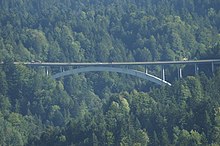High bridge
In the imperial building regulations for the Kaiser Wilhelm Canal, today the Kiel Canal , a bridge was referred to as a high bridge with a clearance height of at least 42 meters above the waterway and a span of at least 140 meters. However, not every bridge with these dimensions is called a high bridge.
Nowadays the term is also used for other bridge dimensions. In addition, some valley bridges and inner-city road bridges are also referred to as "high bridges ".
High bridges over the Kiel Canal
Building and construction
The high bridges over the Kiel Canal were mostly built of steel. The ramps are very long so that the gradient does not make traffic difficult. In order to overcome the difference in height, a loop was built in the case of the Rendsburg high bridge, which was built for train traffic, where the station is only about 1 km from the canal bank . The district of the same name was later created there.
Like all tall buildings, high bridges near airfields must be secured with a red light signal at their highest point. When using the road, at least one windsock must also be attached so that road users know whether they can safely use the bridge.
Well-known high bridges over the Kiel Canal
- Holtenau high bridges
- Levensau high bridges
- Brunsbüttel high bridge
- Hochdonn high bridge
- Hohenhörn high bridge
- Grünental high bridge
- Rendsburg high bridge
- Rader high bridge near Rendsburg
Other "high bridges"
Bridges that also have “Hochbrücke” in their name do not necessarily have to cross waterways. The Lingenau high bridge in Vorarlberg spans a valley cut at a height of 90 meters, and the Freimann high bridge in Munich leads the federal motorway 9 over several streets and a railway line. The historic Munich high bridge , which led a main street of the city over one of the Munich city streams , got its name in the 14th century because it rose above street level as a vaulted stone bridge - unlike the flat wooden bridges customary at the time.




